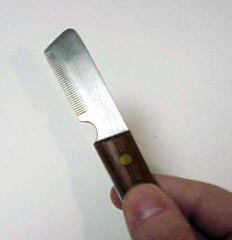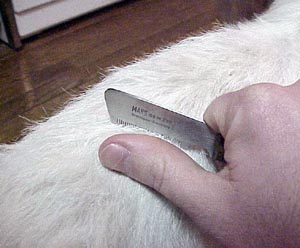Grooming Rough Coated Jack Russell Terriers
Rough and broken coated Jack Russell Terriers are groomed for three basic reasons: appearance, comfort, and most importantly, to help the dog continue to develop a good hard coat that will repel water.

Why Groom your Dog?
Rough and broken coated Jack Russells are groomed for three basic reasons: appearance, comfort, and most importantly, to help the dog continue to develop a good hard coat that will repel water. Ideally, grooming is done twice yearly. An initial grooming in February will have your dog's coat in good condition by late March or April and will keep him more comfortable in summer. If shown, his coat will be back to normal before the trial season begins. Groomed again in late August, the coat will be in a good, natural condition by the Nationals in October, and the dog will have a full coat for winter. No dog should be groomed immediately prior to (or at) a trial, and no foreign substance such as chalk should ever be used prior to judging.
How to Groom
Many owners do not believe in cutting the hair but, rather, pluck or pull it. If you simply cut the hair off, dead hair shafts remain in the skin. Nature will push them out eventually, but in the meantime, new growth will be uneven and the dog will always look unkempt.
If you are careful to separate the long hairs by combing or brushing in small sections (after the initial brush-out) and then pluck or pull only a few hairs at a time, you'll remove the dead hair and new growth will be even. Moreover, the new hairs will be coarser. The dog doesn't mind the grooming process.
Be sure to talk to your dog while you are grooming him. If you don't say anything, but just pull hair, he will get bored and start moving around. If the dog resists grooming in one area, move to another; you can always go back. Nonetheless, try to develop a system to follow.
The following sections are provided to describe the stripping process.
Equipment
 There are no hard and fast rules about the tools to use when you groom your dog. If a comb works for you, for example, use it. You might want to keep on hand a wide-toothed comb, wire brush, a short serrated knife with a dull blade, a short serrated knife with a sharp blade and a pair of thinning shears. A grooming table is helpful, but not a must. A good mat to stand the dog on is important; it will provide your dog with stable footing and make the job easier for both of you.
There are no hard and fast rules about the tools to use when you groom your dog. If a comb works for you, for example, use it. You might want to keep on hand a wide-toothed comb, wire brush, a short serrated knife with a dull blade, a short serrated knife with a sharp blade and a pair of thinning shears. A grooming table is helpful, but not a must. A good mat to stand the dog on is important; it will provide your dog with stable footing and make the job easier for both of you.
Assessing your Dog
Before you begin grooming your dog, evaluate him. Try to get a sense of the dog's conformation.
Where to Begin
Try to be methodical. First, brush or comb the entire dog. Then, begin grooming at the head and work your way down his body, leaving the sensitive areas until last; when the dog has learned to trust you, he will be less nervous. If the dog gets fidgety, move to another area. To groom his face, pull the skin taut, firmly grasp a few adjoining hairs between your thumb and forefinger (or thumb and dull knife) and pull in the direction of growth.
The Sides
You may want to leave a few eyebrow hairs and whiskers around the lips. Remove only as much hair from the face as will make the dog look neat, and to give his face definition. Be sure that both sides of his face are even. You'll know you are finished with an area when you see the neat white undercoat. If you touch the coat, you'll feel both the undercoat and, if you arc a little late with your grooming, some newly emerging rough coat.
The Neck
 Keep the neck skin taut in the area where you are grooming. Begin at the back of the neck and work around to the front. The hair is likely to go wild around the cowlicks. Pull the skin back in small areas and pluck a few hairs at a time, working around the cowlick. When the head and neck are plucked, you may want to take the sharper knife and gently -- barely touching the fur -- comb in the directions of hair growth. You want to remove only the long hair.
Keep the neck skin taut in the area where you are grooming. Begin at the back of the neck and work around to the front. The hair is likely to go wild around the cowlicks. Pull the skin back in small areas and pluck a few hairs at a time, working around the cowlick. When the head and neck are plucked, you may want to take the sharper knife and gently -- barely touching the fur -- comb in the directions of hair growth. You want to remove only the long hair.
The Chest
Remember to brush the hair away from its direction of growth so you can see where it is, then pull toward the direction of growth, keeping the skin underneath taut.
Legs
The bumps on the knees of rough and broken-coated Jack Russells are usually just hair. As you groom the legs, you'll notice that the bumps suddenly disappears. Groom the back legs also; you want to see the lines of the stifle. Don't forget to show the feet. The dog won't like it, so you may have to go back and forth to them between grooming other parts. It is acceptable to use scissors to trim the hair between the toes.
Legs and Back
You could just take scissors and trim your dog, but you would be doing him no favor and not helping his coat to improve. Take the time to pluck the hair. Dogs mind having the shoulders and back done less than almost any other part of their body. Take your time; comb or brush the hair away from the direction of growth, grasp a few long hairs, tighten the skin, and pull in the direction of growth.
Long hairs tend to get dirty and make the dog uncomfortable. Gentle use of the dull knife will preserve the cowlicks, but get rid of excess hair. You can make the skin the area taut by pulling upwards on the dog's tail.
Use scissors to trim and remove the urine-soaked hair. If you are not experienced, you may want to ask someone to hold your dog for you at this time. The same applies for the area around the nipples, before she whelps. It is not uncommon to see rough-coated bitches groom themselves prior to whelping, by pulling the hair with their teeth; you can be a real help to her by doing it for her.
The Tail
While you will pull long hairs the length of the tail, you may find thinning scissors useful (and acceptable) at the tip of the tail. After you've groomed the long hairs from the rest of the tail, hold the tip and clip the few extra long hairs to make the end of the tail next.
The Final Steps
When you have completed the job, take a good look at your dog from all angles. You'll likely find that you've missed a hair here or there that you'll want to remove. This is also the time to go over your dog with the dull stripping knife, if you wish. Be especially careful as you work down his backbone. The vertebral bumps are easily skinned and nicked.
The End Result
If you are new at grooming your dog (and your dog is new to grooming) you may want to split the grooming into two sessions. That's fine the first time, but work toward doing it all at once. It's good discipline for your dog, and you'll only have to clean up once.
Some Afterthoughts
Go over your dog again in 4-7 days. You may find some yellowed (dying) hair that you missed, or that has grown out enough to be removed. Repeated grooming by this method will give your dog a more wiry, water-resistant coat.
Grooming time is also a good time to check your dog's ears and to clean them, using cotton balls only. If you see evidence of mites, or the ears smell foul, consult your veterinarian for both cause and treatment.
If you do not routinely weigh your dog, grooming time is also a good time to do that. It will help you keep track of how the dog is doing on the diet you feed him.
This is also a good time to check your dog's toenails, and clip them. This is not, however, the only time to check and clip his nails.
If your dog has fleas, use a flea powder or spray. Some owners avoid bathing their dogs. They are often out in the rain which helps clean them, but good grooming results in a coat that sheds dirt; good grooming is more important than bathing. If bathing is absolutely necessary, do so at least two weeks before you show the dog to give his coat a chance to recover. Water is not detrimental to a Jack Russell Terrier's coat, but shampoo is -- it softens the coat.
Cornstarch mixed with baby powder in equal parts makes a good dry shampoo. Work the powder into the coat and, using a brush, remove it. Be sure to remove all of the powder.
On collars: Check your dog's neck often to be sure that whatever collars you are using are not irritating his/her neck. Avoid leaving hard collars (such as those that come with invisible fencing or anti-barking collars) on at all times; they can seriously damage the skin underneath. Any flat collar left on at all times will damage the fur beneath it. Use rolled collars in either leather or nylon.
HOW TO GROOM YOUR ROUGH-COATED JACK RUSSELL TERRIER
by Jose Rico & Marion E. Prilook
February 1990